Have you ever found yourself overwhelmed trying to manage information? Picture this: hundreds of spreadsheets sprawled across your desktop, all trying to hold your favorite recipes, those must-see movies, and countless tasks for your side business.
All that complexity can make organizing data feel like searching for a needle in a haystack! But fear not! In this video, we’ll demystify the world of databases—the unsung heroes that help us bring order to our chaotic lives.
By the end, you’ll understand not just what a database is, but why using free database software could be a game changer for you, whether for work or play.
Let’s dive into how databases are akin to magical filing cabinets where every piece of data gets a home.
You wouldn’t just throw your important documents into a box, similarly, databases allow you to categorize, retrieve, and analyze your data effortlessly.
In fact, research shows that organized data can boost productivity by as much as 25%! Imagine being able to ask your database logical questions like, “What were my best-selling products last month?” or “Which movies did I watch that were released last year?” It’s about working smarter, not harder, and who wouldn’t want that?
But here’s the kicker—many folks hesitate to explore databases simply because they fear the technical complexities or the costs involved.
That’s where free database software enters the scene, like a trusty sidekick.
These tools not only bring the power of data management within reach but come packed with features that rival paid versions.
You see, using a database isn’t just for big corporations, students tackling projects, small businesses launching e-commerce sites, and hobbyists wanting to track personal projects can all benefit from these resources without dropping a dime.
That’s right! Now you can focus on what really matters—getting creative and achieving results.
As we go through some of the best free database solutions today, we’ll explore how each offers a unique set of features and strengths tailored to different scenarios.
Whether you’re a budding entrepreneur needing to keep your customer information organized or a tech enthusiast eager to build your next app, there’s a spot for you in the database world! By the end of this video, not only will you feel empowered to choose the right software for your needs, but you’ll find yourself itching to experiment with the world of databases—proving that keeping everything organized makes life a lot more fun!
Introduction to Free Database Software
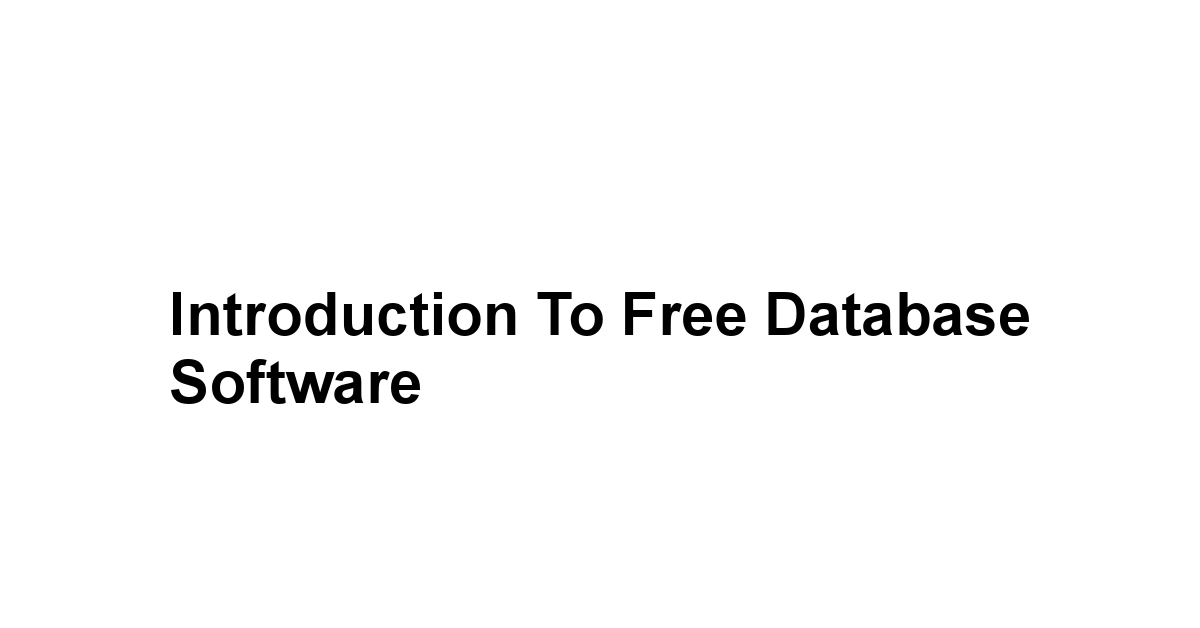
Have you ever wondered what a database really is? It’s pretty fascinating! A database is essentially a structured collection of data that allows us to store, retrieve, and manage information effectively.
Imagine being able to organize everything from a simple list of your favorite movies to massive amounts of information for businesses! Databases are everywhere, powering applications and services that we often take for granted.
Now, why should you consider using a database? The main reason is efficiency.
When your data is organized, it becomes easier to access and manipulate.
Whether you’re a student working on a research project, a small business owner tracking sales, or a developer creating an app, databases help keep your work streamlined.
Plus, free database software options give you a chance to dive into data management without breaking the bank.
Who wouldn’t want to harness the power of data at no cost?
What is a Database and Why Use One?
At its core, a database can be likened to an electronic filing cabinet.
You have tables like drawers, which hold data in rows and columns.
Each piece of information is stored in an organized manner, making it easy to find later.
But why go through the trouble of setting one up? Well, consider this: without a database, managing a large amount of information can become overwhelmingly chaotic.
You might find yourself searching through countless spreadsheets or documents trying to locate a single piece of data.
A database efficiently handles that chaos!
Most databases allow for complex queries.
This means you can retrieve specific data based on various criteria.
For instance, you could ask your database, “What are all the movies directed by Christopher Nolan released after 2010?” and, bam, you have your answer.
Databases also support multiple users, which is perfect for collaboration.
With shared access, team members can work together in real-time, further enhancing productivity.
Benefits of Using Free Database Software
Free database software has gained immense popularity, and it’s easy to see why! First, cost-effectiveness is a major advantage.
Why pay for something when there are excellent options available at no charge? You’re not compromising on functionality either, some free software is packed with features that can match or even surpass premium alternatives.
Another significant benefit is community support.
Many free database software options are open-source, allowing users to contribute to their development.
This active community can provide assistance, share best practices, and create resources that enhance your experience.
You’re never truly alone in your learning journey!
Moreover, free database software allows for experimentation.
If you’re unsure about what works for your needs, you can easily switch between options without losing money on expensive licenses.
This flexibility is especially beneficial for students or startups that are just starting out.
Common Use Cases for Free Database Solutions
So, what are some specific scenarios where free database software shines? Let’s break them down!
- Academic Projects: Whether it’s a capstone project, a thesis, or research data collection, free database tools can help students manage their data effectively.
- Startups and Small Businesses: Get your operations off the ground without hefty software costs. Free databases are perfect for inventory tracking, customer management, and more.
- Application Development: For developers, integrating a database into your applications is crucial. Many free options like MySQL or PostgreSQL are great for building robust backends.
- Personal Projects: From tracking your fitness journey to managing your book collection, free database software can help you keep your personal information organized.
Curious about more creative ideas? Keep exploring and you might find even more exciting use cases for these powerful tools!
Overview of the 6 Best Free Database Software
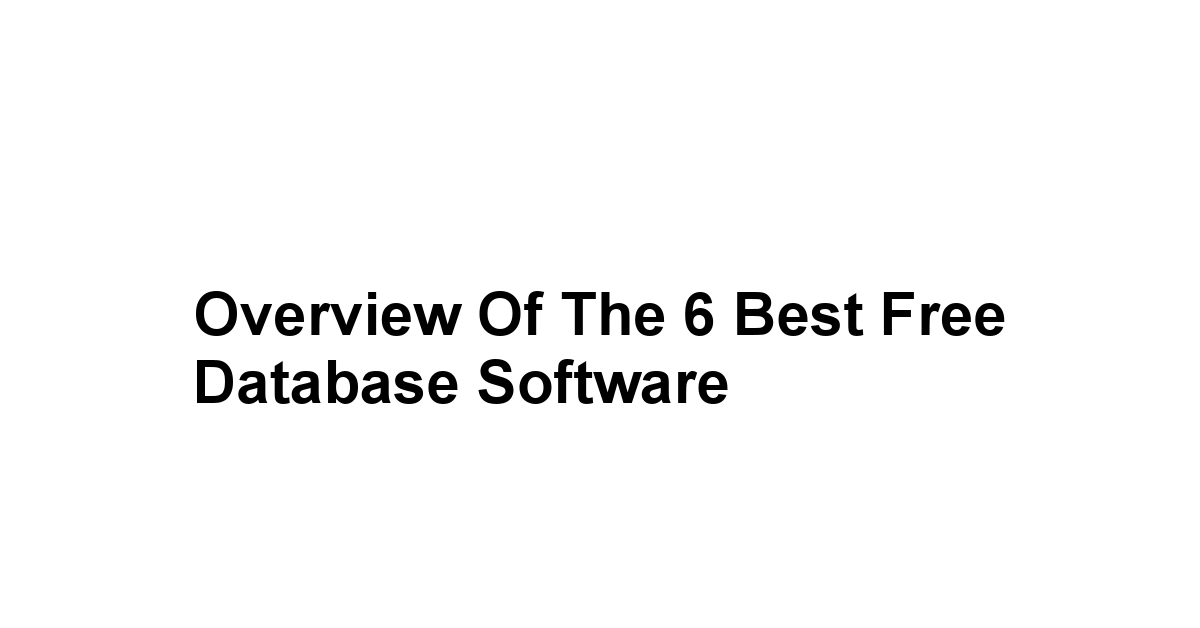
Now, let’s dive into the good stuff! There are so many options out there, and it can feel a bit overwhelming.
But don’t worry, we’re going to go through an overview of the six best free database software solutions available today.
Each one has its unique strengths, and understanding them can help you decide which one fits your needs best.
We’re talking about MySQL, PostgreSQL, SQLite, MongoDB Community Edition, MariaDB, and Apache CouchDB.
Let’s get a taste of what each one has to offer, shall we?
Brief Introduction to Each Software
-
MySQL: MySQL is super popular for a reason! It’s an open-source relational database management system that is known for its performance and reliability. It’s widely used in web applications, especially with PHP. Did you know that over 12 million installations are currently active?
-
SQLite: SQLite is unique because it’s a serverless database contained within a single file. It’s lightweight and is perfect for mobile apps or embedded systems. Despite its simplicity, it’s widely used, powering apps like Adobe Photoshop. Ever used an app that just works seamlessly without a complex setup? You might have been using SQLite without even realizing it!
-
MongoDB Community Edition: MongoDB is a NoSQL database that allows for flexibility in data storage. It stores data in documents rather than tables, making it ideal for unstructured data. The Community Edition delivers essential features for free, and it’s especially popular among developers dealing with big data.
-
MariaDB: A fork of MySQL, MariaDB was created to ensure that the users do not fall into the trap of vendor lock-in. It’s known for faster performance and enhanced security features. Plus, it’s fully compatible with MySQL, so switching is pretty seamless!
-
Apache CouchDB: CouchDB offers an interesting approach by emphasizing a schema-free design using JSON for documents and JavaScript for querying. This makes it great for applications requiring flexibility in data representation.
Isn’t it exciting how diverse these options are? Each has something unique to offer, so there’s definitely a fit for every project!
Factors to Consider When Choosing a Free Database Software
Choosing the right free database software can feel like a daunting task, but breaking it down into a few key factors can make it easier.
Let’s explore some questions you should ask yourself.
- Functionality: What features do you need? Some databases excel in handling complex transactions, while others thrive with simpler data types.
- Ease of Use: Consider your technical skills. Some databases have a steeper learning curve than others, so select one that matches your comfort level.
- Community Support: Is there an active community you can reach out to for help? Check forums and online resources—this can be a lifeline when you’re stuck!
- Performance: Think about the scale of your project. High performance under heavy loads may be necessary if you’re working with large amounts of data.
- Scalability: Will your database need to grow over time? Some database solutions are easier to scale than others, so keep future needs in mind.
Once you have these factors clear, into your options will feel much more manageable!
1. MySQL
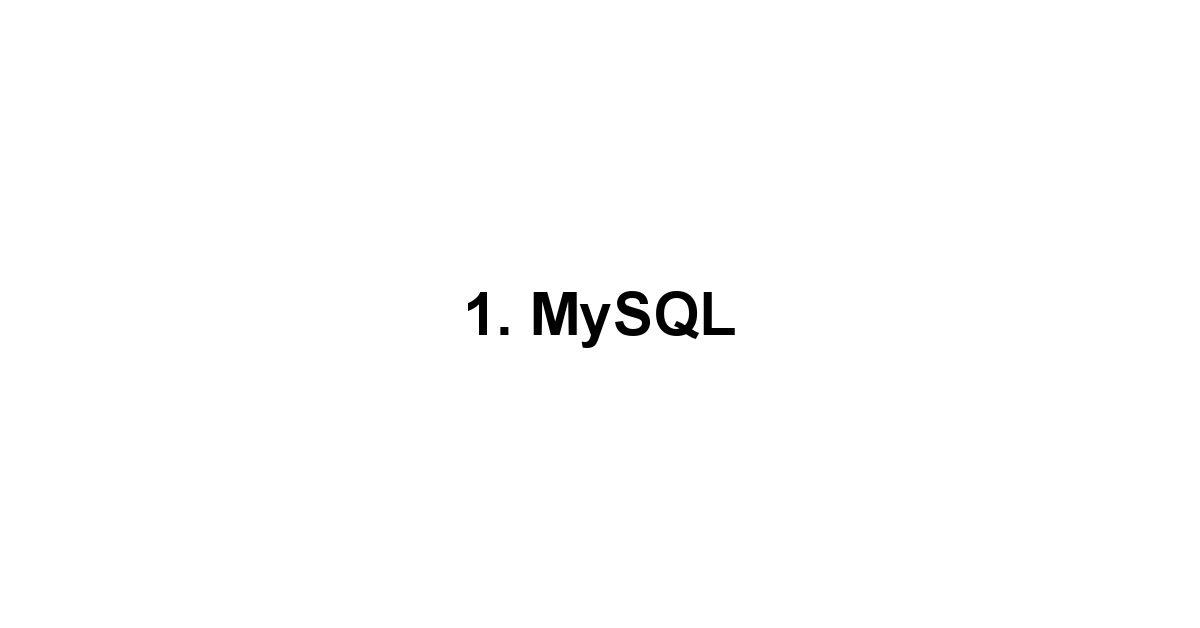
Key Features of MySQL
MySQL is often recognized as one of the best free database systems out there.
With its ease of use and powerful features, it has earned its reputation.
So, what makes MySQL stand out?
- Reliability and Performance: It’s designed for high-speed operations. MySQL can handle large volumes of data while still giving you the performance you desire.
- Compatibility: It works seamlessly with various programming languages such as PHP, Python, and Java, opening many doors for app development.
- Security: MySQL provides robust security features, including user privileges and SSL support for data encryption, making it a safe bet for sensitive data.
- Replication: MySQL offers replication capabilities, allowing you to copy data between servers for redundancy and backup.
According to surveys from DB-Engines, MySQL consistently ranks as one of the top relational databases worldwide.
Isn’t it cool to know so many developers trust MySQL for their projects?
Ideal Use Cases for MySQL
When it comes to choosing the perfect use case for MySQL, the options are exciting! Here are some scenarios where MySQL shines the brightest:
- Web Applications: MySQL is the backbone for numerous websites and applications. Popular platforms like WordPress, Joomla, and Drupal utilize MySQL for their data management.
- E-commerce Platforms: If you’re an entrepreneur launching an online store, MySQL can handle product catalogs, orders, and customer data seamlessly.
- Data Warehousing: MySQL can be integrated into data warehousing solutions for persistence and easier analysis of large datasets.
With its versatility, MySQL can adapt to both small-scale and enterprise-level applications!
Getting Started with MySQL
Jumping into MySQL can feel like an adventure! Here’s how you can embark on this journey:
- Download and Install: Head over to MySQL’s official website and download the community server version.
- Set Up a Database: After installation, use commands or the MySQL Workbench GUI to create your first database.
- Learn SQL Basics: Familiarize yourself with SQL Structured Query Language to manage your data. There are fantastic resources, like Codecademy, that make learning SQL fun!
Have fun exploring the vast capabilities of MySQL!
2. PostgreSQL
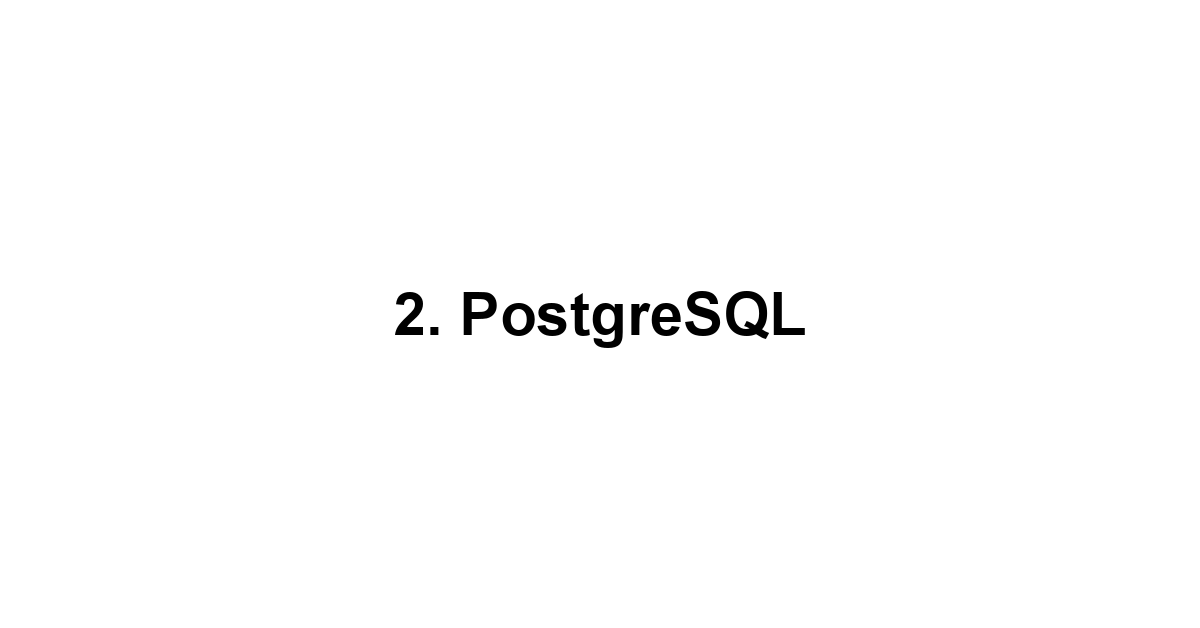
Key Features of PostgreSQL
When it comes to advanced functionality, PostgreSQL takes the cake! This open-source relational database system is packed with features that cater to complex requirements.
Here’s what’s exciting about PostgreSQL:
- ACID Compliance: PostgreSQL guarantees transactions are processed reliably, as it adheres to the principles of ACID Atomicity, Consistency, Isolation, Durability. You can trust your data to be safe!
- Advanced Data Types: PostgreSQL supports various advanced data types, such as JSON and XML, allowing for flexible storage methods.
- Extensibility: The real treasure lies in PostgreSQL’s extensibility; you can create your functions, custom data types, and even add new operators!
- Full-text Search: Out of the box, PostgreSQL provides full-text searching capabilities, making it easier to deal with text-heavy datasets.
Statistics show that PostgreSQL is used by some of the biggest names in tech like Apple and Instagram due to its impressive capability! Isn’t that something to obsess over?
Ideal Use Cases for PostgreSQL
PostgreSQL’s robust features make it fitting for various applications.
Here are some ideal scenarios:
- Geospatial Applications: With its PostGIS extension, PostgreSQL handles geographic objects, making it perfect for mapping and location-based services.
- Financial Applications: Its support for complex queries and ACID compliance makes it suitable for banking systems and financial applications where data integrity is paramount.
- Enterprise Solutions: Numerous enterprises utilize PostgreSQL for data warehousing and analytics due to its scalability and performance under heavy loads.
PostgreSQL truly is a powerhouse for structured data management!
Getting Started with PostgreSQL
Ready to jump into PostgreSQL? Here’s a step-by-step guide to help you get going:
- Download and Install: Visit the PostgreSQL official website to download the installer for your operating system.
- Initial Configuration: After installation, use tools like pgAdmin to create your database easily.
- Learn PostgreSQL Basics: Resources like PostgreSQL’s documentation are invaluable for grasping core concepts and SQL syntax.
Dive headfirst into the impressive world of PostgreSQL!
3. SQLite

Key Features of SQLite
SQLite is often touted as the lightest solution for data management, but that doesn’t mean it skimps on features! Here’s what you can expect:
- Lightweight and Efficient: SQLite is a file-based database, meaning all data is stored in a single file. This makes it incredibly portable and simple to use.
- No Configuration Required: Setup is a breeze! There’s no server installation or configuration; just throw your database file into your application, and you’re good to go.
- Transactions: Even though it’s lightweight, SQLite still supports transactions, allowing you to maintain data integrity.
- Cross-platform: It runs on various platforms, including smartphones and desktops, making it incredibly versatile.
Interesting fact: SQLite is the most deployed database engine in the world, found in countless applications and web browsers! Can you believe that?
Ideal Use Cases for SQLite
Given its simplicity and portability, SQLite is perfect for certain projects.
Some use cases include:
- Mobile Applications: Major mobile apps, including many popular ones, utilize SQLite to manage data efficiently.
- Web Development: SQLite powers lightweight web applications and can serve well when you don’t need the overhead of a more complex database.
- Testing and Prototyping: Its ease of use makes SQLite a go-to for quickly prototyping applications or testing components in isolation.
The possibilities with SQLite are definitely enticing!
Getting Started with SQLite
Ready to start with SQLite? Here’s how you can begin:
- Download and Install: You can download SQLite from the SQLite official website across different platforms.
- Create a Database File: You can create a new database file using the command line—just type
sqlite3 your_database_name.db. - Familiarize Yourself with SQL Commands: Explore the documentation on SQLite’s official website to learn the basics of SQL commands.
Enjoy the simplicity and speed of SQLite for your next project!
4. MongoDB Community Edition
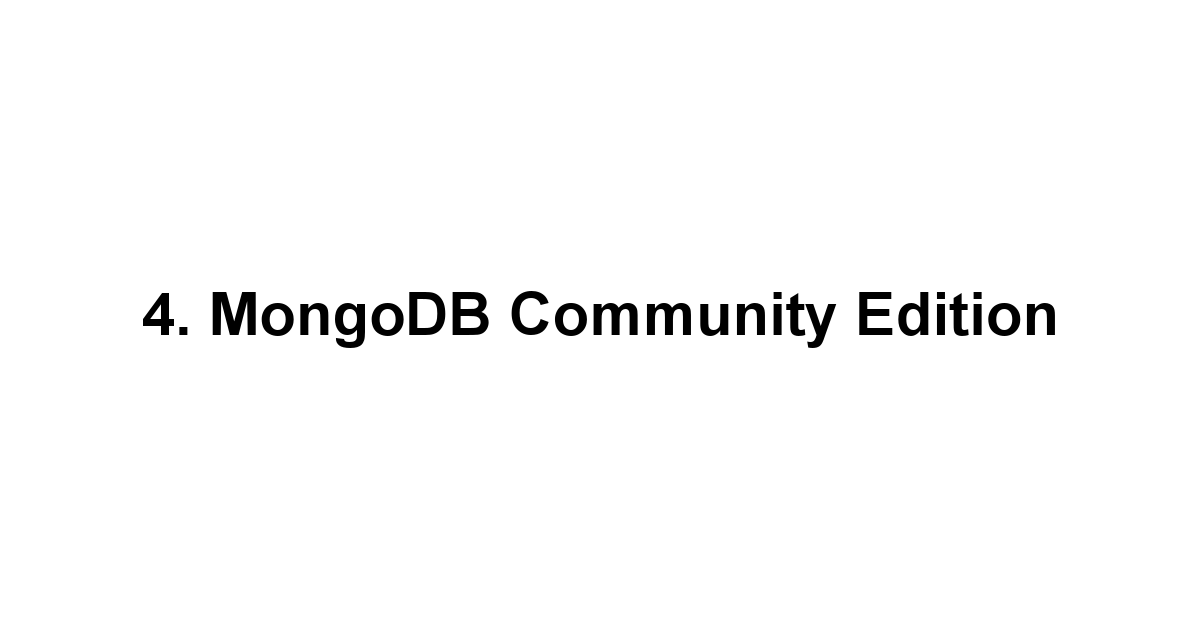
Key Features of MongoDB
Here’s what it brings to the table:
- Document-Oriented Storage: Data is stored in JSON-like documents, allowing for varied structures within the same collection. This flexibility is a game changer for unstructured data.
- Horizontal Scalability: MongoDB can easily scale across many machines, which is perfect for applications expecting massive growth.
- Rich Query Language: You can perform complex queries through its rich query language, making retrieving and analyzing data efficient.
- Built-In Sharding: For large datasets, MongoDB’s sharding offers a highly efficient approach, distributing data across multiple instances.
Did you know that many companies, like eBay and UPS, use MongoDB to handle their data needs? That’s a testament to its capability!
Ideal Use Cases for MongoDB
MongoDB thrives under specific conditions.
Here are some perfect use cases:
- Big Data Applications: It’s ideal for IoT or real-time analytics applications where massive amounts of unstructured data are generated.
- Content Management Systems: The flexibility of data structures allows for easy content management and storage of large volumes of varied content.
- Real-time Applications: For applications needing immediate data processing, like live social media feeds or chat applications, MongoDB can shine!
The versatility and capability of MongoDB truly make it a unique player in the database world.
Getting Started with MongoDB
Eager to dive into MongoDB? Follow these steps to get started:
- Download and Install: Head over to the MongoDB official website and download the Community Edition.
- Set Up Your Database: Use MongoDB Compass for graphical database management or the command line for more control.
- Learn MongoDB Basics: Start with the fantastic learning resources available on the MongoDB University for free online courses.
Embrace the flexible world of MongoDB and unleash your creativity!
5. MariaDB
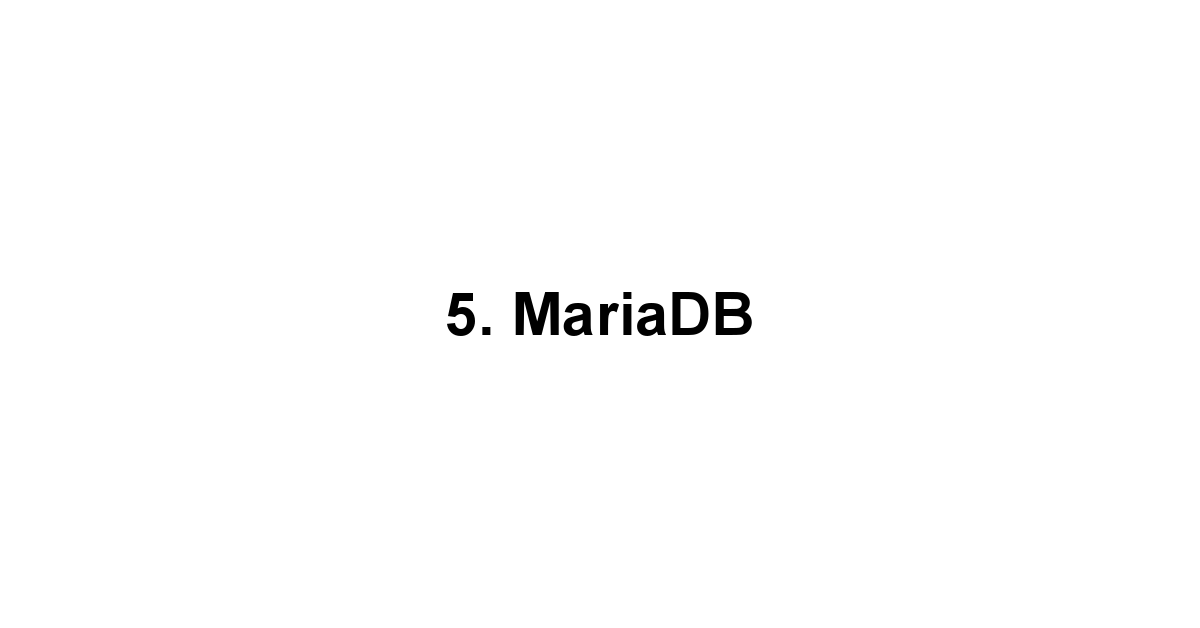
Key Features of MariaDB
MariaDB, being a fork of MySQL, inherits many capabilities while bringing its enhancements.
Here are few key features:
- Performance Improvements: MariaDB offers enhancements like the Aria storage engine for faster performance over MySQL.
- Dynamic Columns: Allowing for flexibility of usage, dynamic columns enable you to have different column structures for different records.
- Security Features: MariaDB emphasizes security with features such as data-at-rest encryption, making it an ideal choice for sensitive databases.
- High Compatibility: Its compatibility with MySQL ensures a smooth transition for users migrating systems, making it easy to adopt.
With many companies making the switch from MySQL to MariaDB, it’s worth exploring what it has to offer!
Ideal Use Cases for MariaDB
MariaDB can be utilized optimally in various situations.
Here are some scenarios:
- Web Applications and Online Services: Just like MySQL, MariaDB is frequently paired with web applications, powering various platforms.
- Large Scale Data Warehousing: With its extensive capabilities, databases of large scales can benefit from MariaDB for efficiency.
- Replacing MySQL: If you’re currently using MySQL, MariaDB offers a simple way to switch without alterations in your applications!
No matter the need, MariaDB is designed to handle it smoothly!
Getting Started with MariaDB
Excited to embark on your MariaDB journey? Here’s a road map:
- Download and Install: Visit the MariaDB official website for the latest version and installation instructions.
- Configuration: Set up your database using commands or tools like phpMyAdmin, which is compatible with both MySQL and MariaDB.
- Explore Resources: The MariaDB Knowledge Base is laden with helpful documentation for learning!
Join the community of users embracing MariaDB for reliable data management!
6. Apache CouchDB
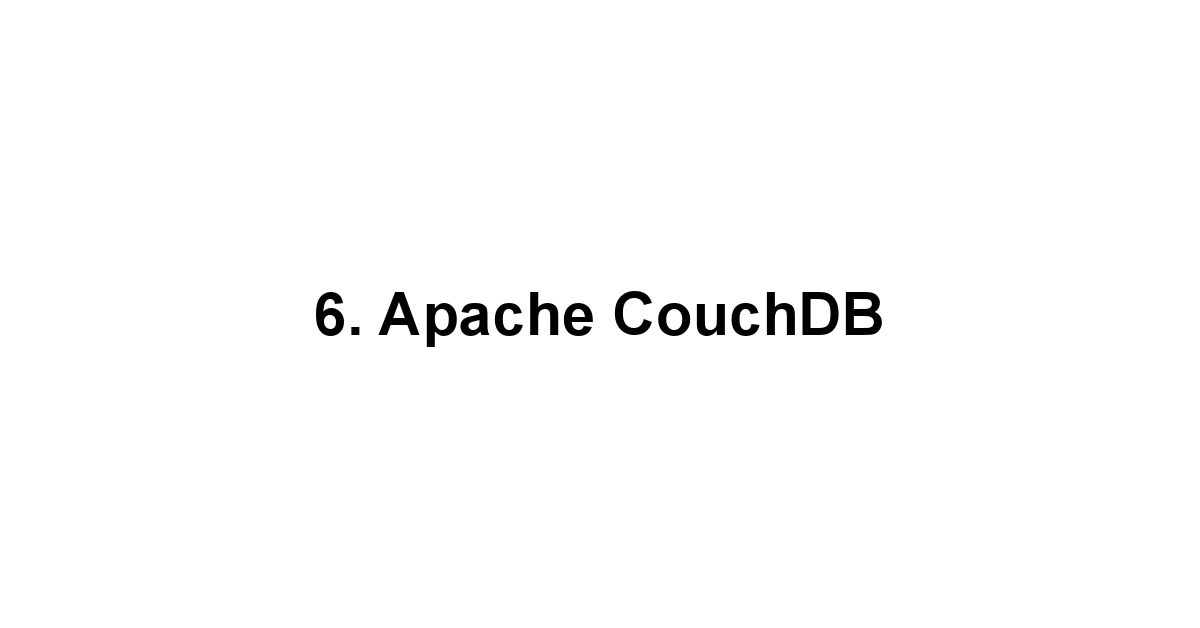
Key Features of CouchDB
Apache CouchDB distinguishes itself as a document-oriented NoSQL database, with unique characteristics that enhance its usability.
Here are some of its standout features:
- Multi-Version Concurrency Control: This allows multiple users to work on the same document without conflicts, making collaboration seamless.
- HTTP/REST API: CouchDB uses a simple HTTP/RESTful interface for database interactions, making integration straightforward for developers.
- Replication: It offers robust replication features, allowing for remote databases to stay in sync effortlessly.
- JSON Document Storage: Data is stored in JSON format, providing a natural way to represent data structures.
CouchDB is an excellent choice for applications demanding flexibility and high availability!
Ideal Use Cases for CouchDB
CouchDB’s distinct features make it suitable for specific applications.
Here are some examples:
- Web Applications: Perfect for dynamic web applications where documents can frequently change.
- Mobile Applications: With its ability to sync data seamlessly and its flexible design, it’s ideal for mobile app back-ends to manage offline synchronization.
- Content Management Systems: Ideal for CMS solutions where documents take center stage and need to be easily modified and stored.
With its ability to adapt, CouchDB can become a valuable asset in your arsenal!
Getting Started with CouchDB
Ready to jump into the world of CouchDB? Here’s how:
- Download and Install: You can find the latest version on the CouchDB official website.
- Interacting with the Database: Use the built-in Fauxton interface to start working on CouchDB more intuitively.
- Learn through Documentation: Immerse yourself in CouchDB’s extensive documentation, available at CouchDB Documentation.
Isn’t it thrilling to explore different database management systems? Each option has something unique, and the world of free databases is full of possibilities!
Tips for Choosing the Right Free Database Software
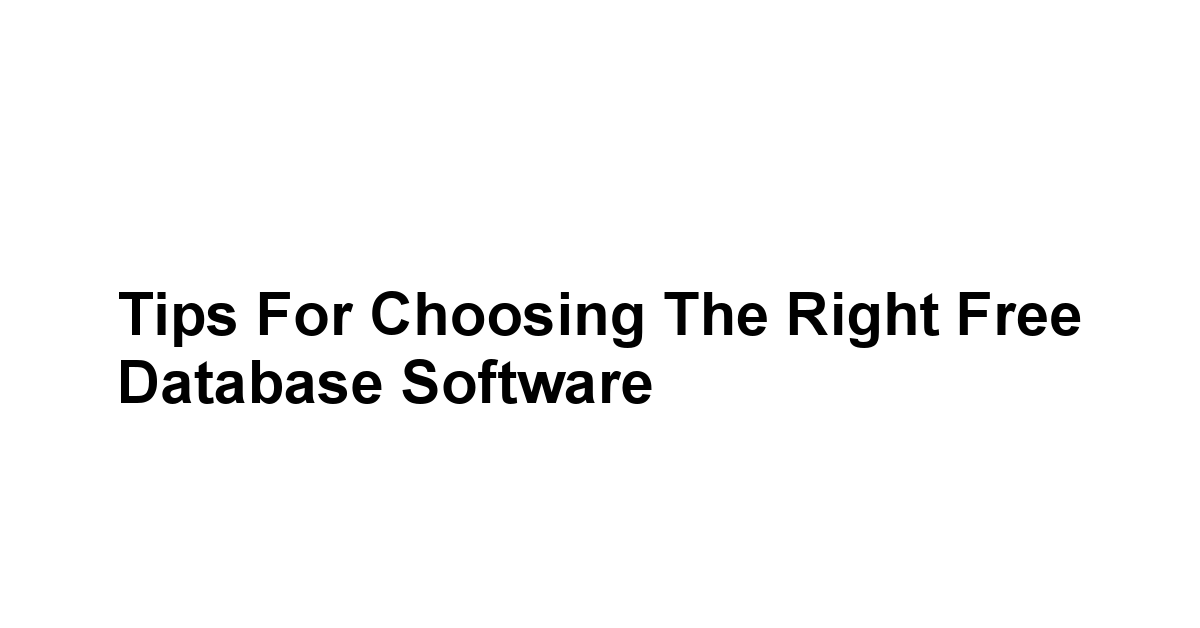
Finding the right free database software requires careful consideration.
The variety available can be overwhelming, so let’s break down some tips to help you make the best choice.
Assessing Your Project Requirements
Before anything else, evaluate what you truly need for your project.
Consider these elements:
- Complexity Level: Will your data be simple or complex? This will dictate whether you need a rich feature set or a straightforward solution.
- Expected Volume of Data: How large do you anticipate your database growing? Selecting a database that can accommodate future growth is crucial.
- Multi-User Access Needs: Are you collaborating with others? You’ll want a database solution that supports simultaneous user access without hiccups.
This self-assessment can guide you toward making more informed decisions!
Understanding Your Data Needs
Next up is understanding your specific data needs.
Ask yourself:
- Data Structure: Are you dealing with structured, semi-structured, or unstructured data? This can help determine whether a SQL or NoSQL solution is appropriate.
- Query Complexity: Will you need to perform complex queries frequently? Depending on your requirements, some databases excel in specific query scenarios.
- Integration Requirements: How will your database interact with other systems? Ensure your choice has the necessary integration capabilities.
Understanding these aspects will help you create a more tailored database solution for your project!
Looking at Community Support and Resources
Don’t underestimate the importance of community support! When you’re working with free software, often you’ll find help online.
Consider these points:
- Active Community: Check for forums, user groups, and online discussions surrounding the database software. Active communities can provide invaluable assistance.
- Documentation Availability: Quality documentation can save you countless hours of frustration. Make sure there are comprehensive guides for getting started.
- Tutorials and Learning Material: Look for resources such as free courses, video tutorials, and blogs that can help you learn quickly.
A strong community can turn a challenging learning curve into a manageable journey!
Final Thoughts
As we wrap up our exploration into the world of free database software, let’s take a moment to reflect on the valuable insights we’ve uncovered together.
The sheer abundance of options—like MySQL, PostgreSQL, SQLite, MongoDB, MariaDB, and CouchDB—illustrates how accessible and powerful data management has become.
Whether you’re a student tackling a significant research project, a small business hunting for ways to streamline your operations, or a budding developer eager to build your next app, there’s a perfect database tailored to fit your unique needs.
Embracing these tools not only empowers your current endeavors but also fosters your personal and professional growth.
The benefits of leveraging free database software extend far beyond just cost savings.
The ability to experiment, learn, and grow with community support significantly enriches your journey.
Since many of these platforms are open-source, you have the opportunity to dive into their development, contribute your ideas, and truly be part of a collaborative ecosystem.
This not only enhances your skill set but also nurtures a sense of belonging within a thriving community of learners and innovators.
Imagine the thrill of exchanging tips with others who share your passion and pushing the envelope of what’s possible together!
Selection is perhaps the most exciting part of this journey.
As you assess your project requirements and understand the specifics of your data needs, the potential for creativity is limitless.
To find the right database, consider not just the features, but also how each solution aligns with the unique objectives of your project.
Will it be simple and structured or complex and dynamic? As you weigh these factors, remember that the right choice will amplify your productivity and make your workflow smoother and more enjoyable.
Ultimately, embracing free database software equips you to harness the power of data to create, innovate, and achieve your aspirations.
Like any journey, it’s filled with trials and triumphs, but the rewards—be it in knowledge, skills, or the successful completion of your projects—are well worth it.
So, let your curiosity lead you, explore the databases out there, and unleash your full potential.
You’ve got this—let the world of possibilities inspire your next big adventure!
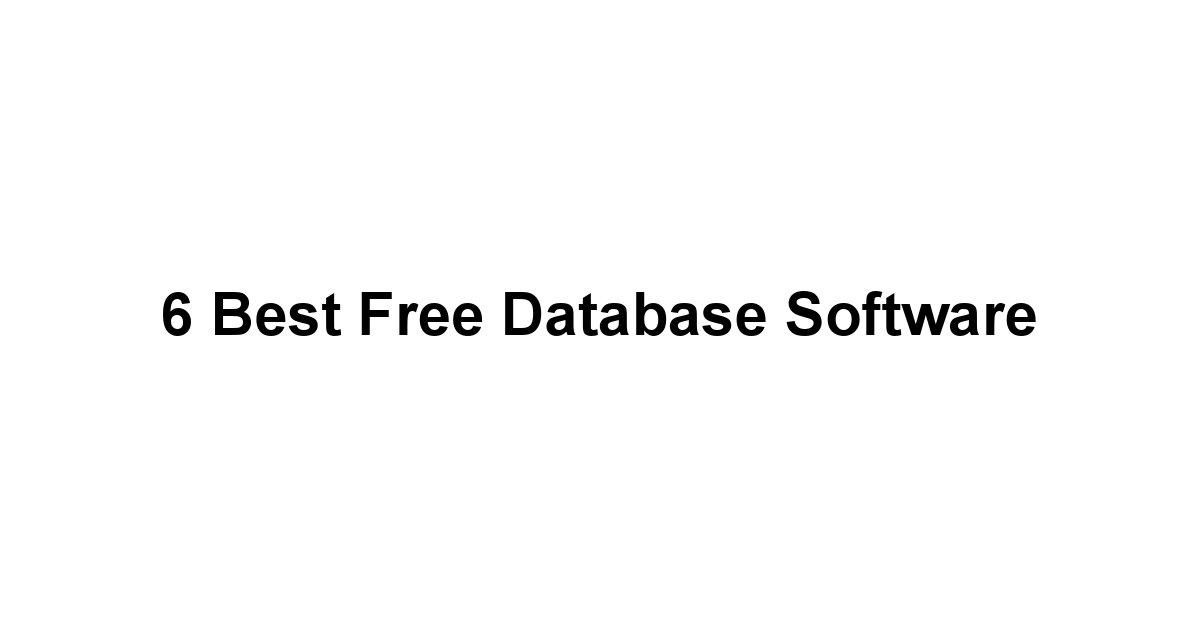




Leave a Reply